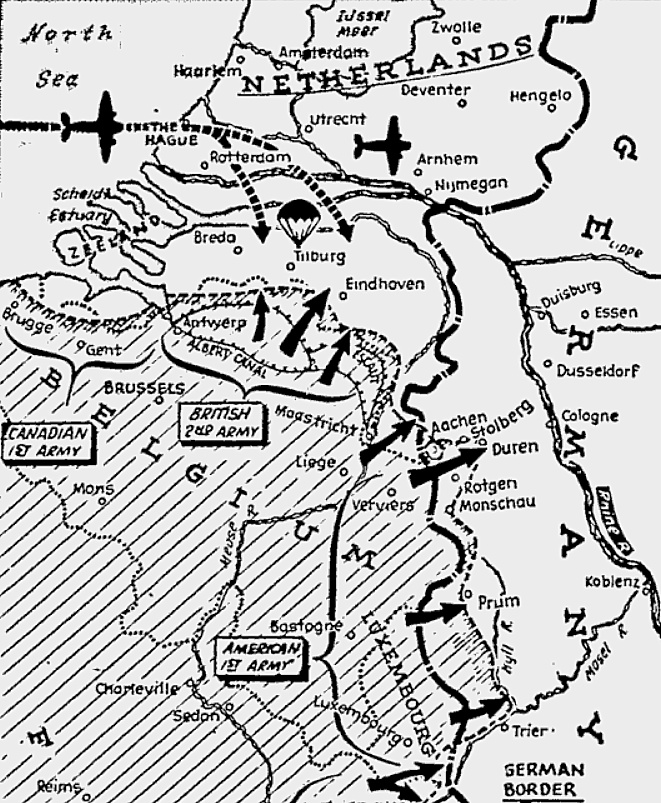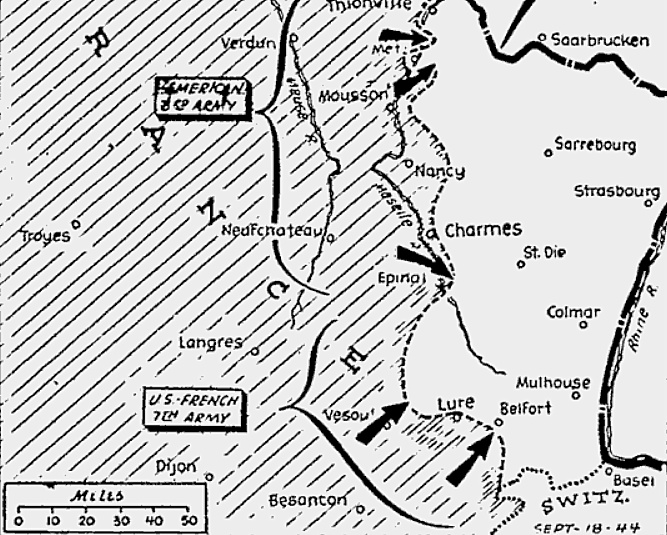The Pittsburgh Press (September 18, 1944)
SKY TRAINS RAIN MORE MEN BEHIND ENEMY IN HOLLAND
Nazis evacuate 13 Dutch villages
Germans hurl troops against Yank wedge beyond Siegfried Line
By Virgil Pinkley, United Press staff writer


Airborne invasion of the Netherlands by U.S. and British troops reached the rear of German forces defending the northern route into the Reich. The British 2nd and the 1st Canadian Armies drove north from Belgium. On the U.S. 1st Army front, troops absorbed several German counterattacks east of Aachen and drove toward Cologne. The U.S. 3rd Army neared the German border in Luxembourg and joined the 7th Army in an assault on the Belfort Gap.
Bulletin
London, England –
A dispatch from U.S. 1st Army headquarters said that counterattacks along the entire front inside Germany had virtually halted the American advance today, but said that all German attempts to push back the Yanks were repulsed.
SHAEF, London, England –
Allied sky trains totaling 285 miles in length today poured reinforcements and supplies down to Lt. Gen. Lewis H. Brereton’s airborne army, which achieved, in heavy fighting, its initial objectives in a bold attempt to turn the Siegfried Line and open the way to Berlin.
A front dispatch apparently written last night said the Germans were fleeing from the Allied invasion by air, and had evacuated at least 13 Dutch towns and villages.
The security blackout still concealed from the German High Command and the world the details of the descent on Holland – details of which the Nazis obviously had not been able to patch into a pattern for use in the defense of northwestern Germany.
Crack German troops shifted westward from the Russian front counterattacked the tip of the U.S. 1st Army wedge which Lt. Gen. Courtney H. Hodges had driven through the Siegfried Line east of Aachen, but the Yanks absorbed the impact handily without the loss of a single pillbox.
United Press writer Jack Frankish, in a 1st Army front dispatch reporting the German counterattack, said it was launched on a small scale than one yesterday.
Counterattacks pushed the Americans back two miles yesterday in the Luxembourg frontier area, but the ground was retaken during the night.
Resistance was stiffening along the entire front within Germany. Artillery and air activity had increased greatly.
U.S. patrols penetrated Germany as far as two miles east of Stolberg, which is five miles east of Aachen, but it was not clear at headquarters exactly how far east of Stolberg the main forces were operating.
Lt. Gen. Sir Miles C. Dempsey’s British 2nd Army smashed forward across the Dutch frontier in a full-scale advance after nearly two weeks of comparative lull. Armor moved from the De Groote bridgehead across the Escaut Canal in the direction of Eindhoven.
Radio Berlin said the 2nd Army and the airborne troops were within five miles of a juncture in the Eindhoven area of southern Holland.
While the geography of the airborne onslaught remained obscure, it was evident that the British were pressing northward for a junction with Gen. Brereton’s forces. A dispatch from the airborne front said the thunder of battle was audible to the south, obviously heralding the approach of the British.
Again at 1:00 p.m. CET today, the hour of action yesterday, the mighty array of planes rained men and material down to the forces in Holland which by Nazi account were in position to push past the north end of the Siegfried Line above the Rhine and into Germany.
All of central England was covered by the sky trains carrying out the reinforcement mission today, while bombers of the U.S. 8th Air Force dropped food, ammunition and fuel in small parachutes called “canopies.”
The airmen expected less danger from anti-aircraft fire today because of the Airborne Army’s gains against enemy positions.
More than 3,000 planes of all types were revealed to have taken part in the airborne attack yesterday. Their losses were described officially as “slight.”
That all was going well was indicated by revelation that one divisional commander radioed from the field today that the parachute missions were “absolutely superb.”
Canadian forces cleaning up the Channel coast were reported in a front dispatch to have fought their way into the main part of Boulogne and the port area. Both infantry and armor were in the southwestern part of the town and were also established on Mont Lambert, the key to the defenses of Boulogne.
Near neck of Channel
Other Canadian forces advanced closer to Cap Gris Nez, at the narrowest neck of the Channel, and only two German defense points, including the Lighthouse, still held out in that area.
Senior officers of the 1st Allied Airborne Army said the D-Day landings in Normandy were small in comparison with the attack on Holland. Originally scheduled for yesterday morning, the air attack was delayed a few hours.
The first reports were so encouraging that senior officers said the Allies can drop behind the Siegfried Line, across the Rhine, or anywhere else they like.
The U.S. 1st Army cut into the German border city of Aachen and drove beyond the breached Siegfried Line to within 20 miles of Cologne, while U.S. 3rd Army troops swung up north of Metz in a sudden strike across Luxembourg that carried up to the Nazi frontier.
Join 7th Army
Other 3rd Army forces thrust down to join with the 7th Army in a frontal assault on the Belfort Gap leading into southwestern Germany, and unconfirmed reports said the Americans reached Belfort itself.
Field Marshal Sir Bernard L. Montgomery, in a message to the British, Canadian and Allied troops under his command, said almost 400,000 Germans have been captured in Western Europe.
“It is becoming problematical how much longer the enemy can continue the struggle,” he said.
In a single giant stride, the airborne army had crossed the flood barrier the Nazis relied upon to protect Germany from invasion through the Netherlands.
Seek knockout
Allied spokesmen, jubilant at the initial success of the hazardous aerial invasion, made it clear that they were playing for the highest stakes – a quick knockout of the German Army.
Gen. Brereton declared flatly that upon the success of the airborne landing “rests the difference between a quick decision in the west and a long, drawn-out battle.”
Berlin admitted the gravity of the Allied threat and warned the people of Holland that the German Army intended to turn their homeland into a battleground and hold it at all costs.
The Nazis said the main Allied concentrations had landed around Eindhoven, Tilburg and Nijmegen, the latter north of the Rhine and only five miles from the German frontier.
At the same time, they hinted that further paratroop and glider landings are expected, as well as a possible seaborne attack on the Dutch coast.
Coast landing reported
One unconfirmed report broadcast by the Vichy radio said Allied sky troops made a new landing today on the seacoast nine miles north of The Hague.
United Press correspondents who flew over Holland with the invading Army reported that Gen. Brereton’s men, mostly American veterans of the Normandy landing but including strong British, Dutch and Polish contingents, were meeting relatively weak opposition from the disorganized Nazis.
Aided by a massive aerial bombardment that temporarily swept the Nazi Air Force from the skies and knocked out virtually every German battery in the landing areas, the sky attack yesterday liberated a number of Dutch villages within an hour and seized scores of vital bridges, canal crossings and rail and highway junctions.
Units of the 1st Canadian Army also moving in on the Netherlands from their positions on the Leopold Canal, on the British left flank.
4000 planes attack
The sudden air strike behind the Nazi lines came on the heels of a 15-hour aerial bombardment during which more than 4,000 U.S. and British warplanes ripped almost continuously at the invasion-marked sector with bombs and gunfire.
The RAF’s heavyweights set the attack In motion before midnight Saturday, and at daybreak Sunday the U.S. 8th Air Force sent its Flying Fortresses and fighter-bombers into action, Even as the first paratroops were tumbling down, U.S. fighter-bombers were swooping in beneath them, uncovering the Nazi gun positions and splattering them with fragmentation bombs.
In all, more than 7,500 tons of bombs were dropped across the Netherlands and nearby enemy airfields in Germany where the Nazi Air Force was known to have concentrated planes to meet Gen. Brereton’s 1,000-plane glider and transport fleet.
Nazis counterattack
The attack promised immediate and serious repercussions on the fighting front south of the Netherlands, where Gen. Hodges’ 1st Army troops were across the German frontier in force along an almost continuous line from Aachen to the Trier sector.
Gen. Hodges’ men were through the Siegfried Line beyond Aachen and striking across open country toward Cologne where the Nazis were reported digging anti-tank trenches and burying tanks in preparation for a full-scale stand on the Rhine. Headquarters had no comment on German reports of fighting at Duran, 20 miles west of Cologne.
Capture 1,000 a day
The Americans met strong opposition farther south in the Monschau area, and around Bollendorf and Echternach, where the Germans counterattacked savagely after falling back from their main Siegfried fortifications.
Despite the sudden stiffening of enemy opposition, German prisoners were still being taken by the 1st Army at the rate of 1,000 a day, including many who discarded their uniforms in a vain attempt to ship through the American lines.
Lt. Gen. George S. Patton’s U.S. 3rd Army forces south of the 1st Army pushed up across Luxembourg at an undisclosed point, north of Metz and United Press writer Robert Richards said they were approaching the German frontier.
Drives on Metz
Gen. Patton’s troops also cut slowly through the ring of forts protecting Metz, where the Germans were reported digging in for last-ditch fight, and cleared both banks of the Moselle River virtually all the way south from Pont-a-Mousson to Charmes.
On Gen. Patton’s right flank, the U.S. 7th Army wheeled an against the Belfort Gap, capturing Montbéliard (10 miles southwest of Belfort), Lure (18 miles west of Belfort) and four other towns on the approaches to the gap.
Other 7th Army troops along the Italo-French border farther south fought their way 11 miles northwest of Modane through the Maurienne Valley to Lanslebourg, where they ran into stiff opposition from German mountain troops.
Radio France in Algiers said the German garrison at Brest had surrendered, but there was no confirmation of the report at headquarters.



